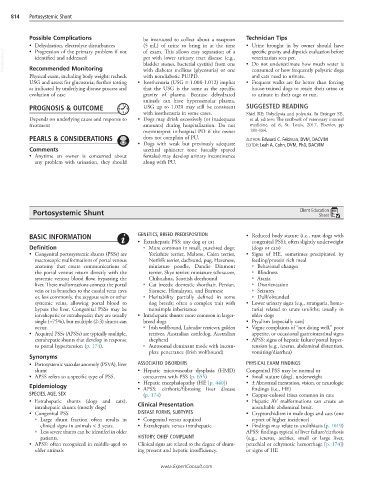Page 1614 - Cote clinical veterinary advisor dogs and cats 4th
P. 1614
814 Portosystemic Shunt
Possible Complications be instructed to collect about a teaspoon Technician Tips
• Dehydration, electrolyte disturbances (5 mL) of urine to bring in at the time • Urine brought in by owner should have
VetBooks.ir Recommended Monitoring pet with lower urinary tract disease (e.g., • Do not underestimate how much water is
specific gravity and dipstick evaluation before
of exam. This allows easy separation of a
• Progression of the primary problem if not
identified and addressed
veterinarian sees pet.
bladder stones, bacterial cystitis) from one
Physical exam, including body weight; recheck with diabetes mellitus (glycosuria) or one consumed or how frequently polyuric dogs
and cats need to urinate.
with nondiabetic PU/PD.
USG and assess for glucosuria; further testing • Isosthenuria (USG = 1.008-1.012) implies • Frequent walks are far better than forcing
as indicated by underlying disease process and that the USG is the same as the specific house-trained dogs to retain their urine or
evolution of case gravity of plasma. Because dehydrated to urinate in their cage or run.
animals can have hyperosmolar plasma,
PROGNOSIS & OUTCOME USG up to 1.020 may still be consistent SUGGESTED READING
with isosthenuria in some cases. Shiel RE: Polydipsia and polyuria. In Ettinger SE,
Depends on underlying cause and response to • Dogs may drink excessively (or inadequate et al, editors: The textbook of veterinary internal
treatment amounts) during hospitalization. Do not medicine, ed 8, St. Louis, 2017, Elsevier, pp
overinterpret in-hospital PD if the owner 181-184.
PEARLS & CONSIDERATIONS does not complain of PU. AUTHOR: Edward C. Feldman, DVM, DACVIM
• Dogs with weak but previously adequate EDITOR: Leah A. Cohn, DVM, PhD, DACVIM
Comments urethral sphincter tone (usually spayed
• Anytime an owner is concerned about females) may develop urinary incontinence
any problem with urination, they should along with PU.
Portosystemic Shunt Client Education
Sheet
BASIC INFORMATION GENETICS, BREED PREDISPOSITION • Reduced body stature (i.e., runt dogs with
• Extrahepatic PSS: any dog or cat congenital PSS); often slightly underweight
Definition ○ More common in small, purebred dogs: (dogs or cats)
• Congenital portosystemic shunts (PSSs) are Yorkshire terrier, Maltese, Cairn terrier, • Signs of HE, sometimes precipitated by
macroscopic malformations of portal venous Norfolk terrier, dachsund, pug, Havanese, feeding/protein rich meal
anatomy that create communications of miniature poodle, Dandie Dinmont ○ Behavioral changes
the portal venous return directly with the terrier, Skye terrier, miniature schnauzer, ○ Blindness
systemic venous blood flow, bypassing the Chihuahua, Scottish deerhound ○ Ataxia
liver. These malformations connect the portal ○ Cat breeds: domestic shorthair, Persian, ○ Disorientation
vein or its branches to the caudal vena cava Siamese, Himalayan, and Burmese ○ Seizures
or, less commonly, the azygous vein or other ○ Heritability partially defined in some ○ Dull/obtunded
systemic veins, allowing portal blood to dog breeds; often a complex trait with • Lower urinary signs (e.g., stranguria, hema-
bypass the liver. Congenital PSSs may be nonsimple inheritance turia) related to urate uroliths; usually in
intrahepatic or extrahepatic; they are usually • Intrahepatic shunts: more common in larger- older dogs
single (≈75%), but multiple (2-3) shunts can breed dogs • Ptyalism (especially cats)
occur. ○ Irish wolfhound, Labrador retriever, golden • Vague complaints of “not doing well,” poor
• Acquired PSSs (APSSs) are typically multiple, retriver, Australian cattledog, Australian appetite, or occasional gastrointestinal signs
extrahepatic shunts that develop in response shepherd • APSS: signs of hepatic failure/portal hyper-
to portal hypertension (p. 174). ○ Autosomal dominant mode with incom- tension (e.g., icterus, abdominal distention,
plete penetrance (Irish wolfhound) vomiting/diarrhea)
Synonyms
• Portosystemic vascular anomoly (PSVA), liver ASSOCIATED DISORDERS PHYSICAL EXAM FINDINGS
shunt • Hepatic microvascular dysplasia (HMD) Congenital PSS may be normal or
• APSS refers to a specific type of PSS. concurrent with PSS (p. 655) • Small stature (dog), underweight
• Hepatic encephalopathy (HE [p. 440]) • ± Abnormal mentation, vision, or neurologic
Epidemiology • APSS: cirrhotic/fibrosing liver disease findings (i.e., HE)
SPECIES, AGE, SEX (p. 174) • Copper-colored irises common in cats
• Extrahepatic shunts (dogs and cats); Clinical Presentation • Hepatic AV malformations can create an
intrahepatic shunts (mostly dogs) auscultable abdominal bruit.
• Congenital PSS DISEASE FORMS, SUBTYPES • Cryptorchidism in male dogs and cats (one
○ Large shunt fraction often results in • Congenital versus acquired report of higher incidence)
clinical signs in animals < 3 years. • Extrahepatic versus intrahepatic • Findings may relate to urolithiasis (p. 1019)
○ Less severe shunts can be identifed in older APSS: findings typical of liver failure/cirrhosis
patients. HISTORY, CHIEF COMPLAINT (e.g., icterus, ascities, small or large liver,
• APSS: often recognized in middle-aged to Clinical signs are related to the degree of shunt- petechial or echymotic hemorrhage [p. 174])
older animals ing present and hepatic insufficiency. or signs of HE
www.ExpertConsult.com

